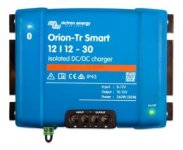Jody,
Thank you for the link to the most interesting video. The main take away was of course that by his "standards" it was cheaper to have a LI than AGM, and a little cheaper than a Flooded Lead Acid (FLA) battery.
Aside from the cold part--which would rarely affect most of us in our C Dorys. He emphasized use of Watt Hours, vs Amp hours. He is absolutely correct.
The Li battery starts at about 13.4 to 13.6 volts, and remains above 12 volts until 90% discharged:
Below from Solacity web site:

If you look at the AGM or FLA battery the resting voltage is 12.6 to 12.8 and "50%" discharge is usually considered at 12.2 volts...If you take much more out of the battery, you begin to deteriorate the batteries longevity. Now in his tests he did take both AGM and FLA to 9 volts, and mentioned that they "recovered". It was not entirely clear that he was making the distinction between a battery under load at 12.2 volts, or a battery at resting state (that is no charge or discharge for at least 2 hours). The 12.2 volts being 50% discharged for a FLA is dependent on the that battery being at rest.
They used a setup almost identical to what I am using in my C Dory 25; That is two BattleBorn 100 amp hour batteries in parallel, to a Victron Multiplus 2000/80/50. This is a 2000 watt PSW inverter with an 80 amp charger. They changed the charging profile with the computer--it can be done with the computer (more flexibility) or with dip switches on the circuit board of the charger. Once set for LIFePO4-=in real use, you leave it there. The remote for the inverter can also set limits of power used for charging, if running off a generator.
I agree with Jody that a Bat to Bat charger is certainly the best way to charge the LiFePO4 battery. However, there are a lot of boaters who are just using the outboard charger--they never get the full amount of power available, and run some risk of damage. The internal Battery Management System (BMS) should prevent any over voltage damage. Many RV's are just using a timing device, with a automatic charging relay, where they let the alternator charge for a period of time (15 minutes, and the rest for 30 minutes to avoid over charging). For example my RV has a 200 amp alternator continuous duty rated, vs the 44 amp alternator of the Honda 150 and 17 amp alternator of the pre 2007 Honda 90.
As I was designing my system I was not "thinking" watt hours, but I was thinking about having the voltage above 12 volts until the last 10%--and I would never use that last 10%. I have my cut off voltage set at 12 volts on the inverter.
Also I feel that one has to have a commitment to using the boat either frequently off grid, wanting to own the boat for a long time, or just wanting to experiment. For the average C Dory owner, I am not sure that the LI battery is worth the cost. In our case, we run a microwave and induction burner for cooking--plus have chest freezer and refrigerator, so there is a constant 24 hour a day low amp draw of the chest freezer/refer, and the short term high amp draw of the microwave and induction burner. Thus we have the need for needing high capacity batteries. IF you just have a Wallas stove, or heater and LED lights, there is probably little need for the Li battery. We are also seeing the Li used frequency in boats which use trolling motors. A 36 volt 110# thrust trolling motor will run many hours on a 36 volt 50 amp battery bank. There is a huge weight savings, and the fishermen will have far more capacity--or use time.
The average FLA lasts 3 or so years. The LiFePO4 battery should last over 12 years, depending on use.




